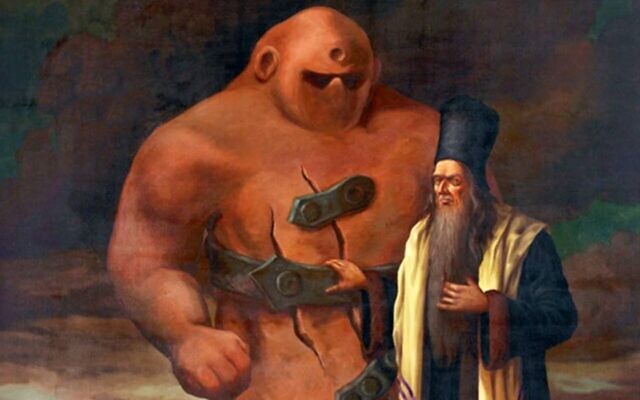
Thanks to popular movies vampires and werewolves are probably the most famous Eastern European creatures. Usually these creatures are evil nightmarish things. But what is a Golem? A monster? A benevolent protector? Is the story fact or fiction? Well, it depends on who you talk to.
One thing is certain, the tale of the Golem is one of the most famous stories of Jewish folklore. The story goes that when persecutors rose up to attack the Jewish people, the Maharal, Yehudah Loew, chief rabbi of Prague 500 years ago, created the Golem, a manlike creature made from the dust of the earth and endowed with "life" by means of a secret formula. Through the Golem, the Maharal brought about miracles for the protection of the Jews in Prague.
Back then, Christian priests falsely claimed that Jews secretly killed Christian children and used their blood in the performance of religious rituals. These hateful sermons caused the Christian townspeople to pour out of church with deep hatred for the Jews. In order to save the Jewish people from slaughter, the Maharal prayed for guidance and he received an answer at night in a vision. He was given 10 Hebrew letters, signifying words meaning "You will create a Golem, a thing of clay that will destroy the wicked!"
He, along with two friends molded a superhuman from the soft mud — the Golem. To bring the Golem to life, The Maharal had to insert a "shem" (a clay tablet bearing the name of G od) into its mouth.
The Golem had the general appearance of a man but is usually depicted as about 8 feet high and very muscular, possessed with enormous strength. He could also disappear at will. The Maharal told the Golem, "We created you with G od's help to protect the Jews against our enemies. You must obey my orders in everything! The Golem could see and hear but was mute. He nodded his head in agreement.
Unlike other mythical creatures of folklore, the Golem was not a monster, but rather a gentle soul that had no independent thought but was morally upright. He did exactly what he was told until he was told to stop by the Maharal. When asked to bring water to the kitchen, he continued to bring water until the kitchen flooded and was then told to stop (a precursor perhaps to The Sorcerer's Apprentice). When he was told to catch fish, he fished all day, and when told that there were too many fish, he dumped the entire basket of them back into the lake.
The Maharal would deactivate the Golem for the Sabbath, to allow the creature to rest. But one day he forgot and the Golem went on a rampage through the ghetto, destroying everything in its path. When the Rabbi was told of this, he eventually confronted the monster outside the synagogue, where he managed to remove the "shem". The Golem was never revived and allegedly was later stored in the synagogue's attic for safe keeping, which remained locked for centuries.
Here are the facts.
The Maharal Yehudah Loew was a real historical rabbi and Jewish scholar but there is no evidence that he actually created a Golem. His synagogue is still in existence in Prague and the attic space above the synagogue where the Golem is supposedly locked up in has since been opened. Nothing at all indicates that the Golem was ever in there.
Through the years there have been many different versions of the story, including several movies. Today, thanks to tourism, the image of the Golem can still be seen in Prague in various forms such as names of restaurants, and tourist souvenirs like key chains and such. However, the Golem legend is not unique to Prague. Golems appear in local Jewish legend across Central and Eastern Europe, the oldest example coming from 16th-century Chelm in Poland.
But Prague's Golem is the most famous of them all.
(COMMENT, BELOW)


 Contact The Editor
Contact The Editor
 Articles By This Author
Articles By This Author